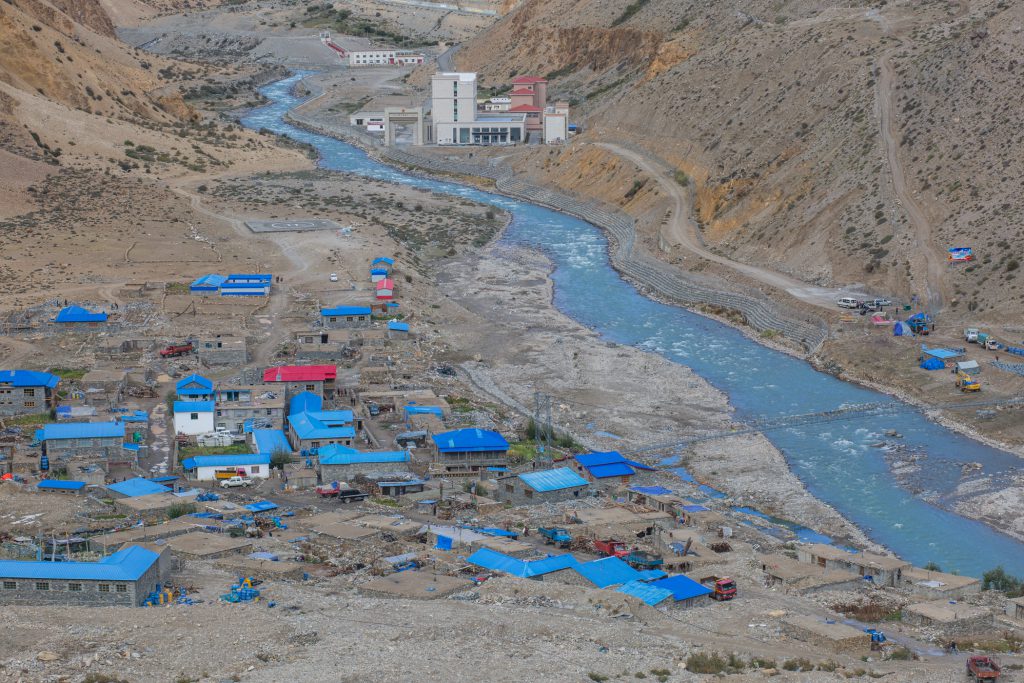At over 22,000 kilometres, China has the world’s longest land border. Lined up along that border are a total of 14 countries, countless local communities and long histories of interaction and isolation, trade and suspicion. The Art of Neighbouring: Making Relations Across China’s Borders (available for download here) is a selection of essays that look at the diverse experiences of living on China’s border from the perspectives of the communities who live with its presence on a daily basis.
From Laos to Nepal, Mongolia and Vietnam, the regions along China’s long border are too often seen as peripheral, on both sides — the northern highlands of Laos and Vietnam border China’s mountainous Yunnan province, Nepal neighbours the Tibetan plateau. But as China’s economic, political and social presence and engagement across the Asian continent expands, not least via the official encouragement of China’s “going out” policy and the more recent Belt and Road Initiative (BRI), the experiences of these border regions are becoming increasingly important in understanding China’s role across the continent. At the same time, it is the communities on both sides of the border who often feel the most direct impacts of the increased interaction being encouraged by Beijing.
In attempting to understand and assess the impact and the on-the-ground reality of the BRI, this year celebrating its sixth birthday, it is important that we acknowledge those communities’ experiences and look at, in the words of the collection’s editors, Martin Saxer and Juan Zhang, the “smaller scale processes of exchange”, which are undergoing rapid change. Through a series of in depth, mostly ethnographic case studies, The Art of Neighbouring is a step in that direction.
The case studies in the book all date from before 2012. That is, from before the Belt and Road Initiative was announced in October 2013. Nonetheless, they reflect the impacts of a trend of China’s increasing presence outside its own borders which holds true both before and after Xi Jinping’s BRI speech in October 2013. Each chapter of the book focuses on a case study from a total of eight of China’s neighbouring countries. Running through those geographically disparate case studies are couple of major themes which deserve highlighting.

Reimagining histories
In a number of the book’s case studies the rapidly increasing interconnectivity with China is not a new phenomenon, but rather a revival of a historical norm. This is particularly evident in the case of Martin Saxer’s ethnographic study in northern Nepal where the trading relationships across a previously porous border was the basis of existence for borderland communities. It was only in the 1960s that the border between China and Nepal became strictly demarcated and regulated. Where trade had once occurred wherever there was a passable valley, it now became limited to just six official border crossings. Before that, highland communities sought their existence as intermediary traders between the arid and harsh Tibetan plateau and the fertile lowlands of Nepal and India. Since the 1970s, China’s increasing wealth and the renewed connectivity brought by new roads linking Nepal’s borderlands much more directly and tightly to China than Kathmandu, revitalised this centuries old norm.
Along with these changing physical realities, local communities have also reimagined their place in the history of China-Nepal relations and understand their current occupations as following in the footsteps of their ancestors as borderland trading communities. “The new roads are primarily conceived of as ways back to what is remembered as prosperous trans-Himalayan exchange,” Saxer writes. In other words, in the eyes of local communities, a rising and more internationally present China is not so much a disruption of the world order, but is facilitating a return to normality after a comparatively brief interlude.
A case study of traders in Kyrgyzstan and Kazakhstan demonstrates a similar historical processes of a border region “under fuzzy sovereign rule” closing its borders during the Cold War and then re-opening in the last thirty to forty years. Henryk Alff’s study of the traders reveals that they often attempted to rekindle (perceived) historical ethnic allegiances across borders with, for example, Hui Muslims in China. One Dungan trader from Kyrgyzstan states, “some of us had remote kinship ties with places in China where our ancestors originally came from.” In the post-Soviet and rising China period, traders have been able to take advantage of these perceived cross-border common identities to facilitate deals and partnerships. It is another example of regional history re-imagined, which in turn informs how local people comprehend China’s growing presence and interconnectivity on the continent.

China as threat/China as opportunity
This leads on to the second major theme in the book’s case studies. Informed by local history and present day circumstances, communities all along China’s border are divided in their perceptions of China as a threat or an opportunity.
In Saxer’s Nepal case study he provides an example of an embracing attitude towards China’s presence. Moreover, it is a welcoming coming from local communities and a bottom-up approach, rather than via top-down government initiatives involving state owned companies, banks and political MOUs through which we normally make sense of China’s presence abroad.
In 2010 a former member of parliament and local to the northern border region of Humla pulled together local business people to form a Road Construction Committee, which lobbied Kathmandu to provide funding to build a road through the lesser used Limi valley to China. They were successful and, after securing funding from Kathmandu, also managed to reach an agreement with China to temporarily open the border through the valley for sales of diesel for the construction equipment. By the end of the year the first section of the road was complete, and a Chinese delegation even came to attend the inauguration ceremony.
In another example, a study of Myanmar Muslim communities residing in Ruili in China’s Yunnan province conducted by Renaud Egreteau between 2009 and 2012, reveals that to these communities China is seen as a refuge and a sanctuary compared to the situation they face at home. One of his Ruili-based Myanmar interviewees even says “it’s paradise here!”
In contrast, the history of Cold War suspicion, tension and conflict along China’s Russian and Vietnamese borders do not wash away overnight. Two case studies of these borderlands show that a perception of China as a threat persists through to this day. A Vietnamese border trader interviewed by Juan Zhang in her study of the Lao Cai – Hekou border crossing says, “even now the Chinese are not much better than before…One can never be too careful.”
Within countries there are of course also divided perspectives on China as threat or opportunity. These as yet unsettled perspectives played out in a number of high profile elections in 2018 in Malaysia, Sri Lanka and the Maldives. 2019 is likely to see more of this tension as more politicians, banks, constituents and other interest groups push back on some of the excesses of Chinese projects and work to establish national level strategies on how to interact (or how not to interact) with China and the Belt and Road. Elections in India and, in particular, Indonesia this year could display snapshots of this trend.
What can we learn?
The voices and the world views of communities experiencing and engaging in China’s increasing global presence are an important part of the Belt and Road “story” and the rapidly changing on-the-ground reality across Asia. For one, they represent world views that are often overlooked in mainstream coverage of China’s influence abroad and the Belt and Road. While media often seek comment from local communities on their attitudes toward a specific project, it is rare to hear their take on the larger scale shifting reality or on such big questions as whether China is primarily conceived of as a threat or as an opportunity. As narratives on BRI become more and more polarised between the Beijing story and the Washington story, or the Brussels story, it is important not to forget the voices of those who are far more directly impacted by the transformational change BRI is bringing to some places.

But these local community voices are not just “colour” for media stories. They are also agents in and of themselves. Saxer’s fascinating case study of a local community proactively campaigning for infrastructure connectivity with China is a case in point. The agency of these local communities is also being played out at a very local level, in national elections and in the establishing of recipient country policies and strategies toward the Belt and Road.
In a recent article on Euromoney, Djiboutian minister of finance, Ilyas Moussa Dawaleh, stated “we have problems with the current Belt and Road narrative”. His voice may represent that of a recipient country political elite, rather than the grassroots voices explored in The Art of Neighbouring, but it points to the same problem — the current narratives of the Belt and Road too often overlook the diversity of agency playing out in its growth and development.
The Art of Neighbouring points a way towards a deeper and more complex understanding of China’s growing presence and engagement on the Asian continent and of the dynamics playing out along the Belt and Road. For these reasons it is useful for all of us in the emerging “Belt and Road watcher” community. Even better will be more recent ethnographic studies of local communities’ perspectives on China since the announcement of the Belt and Road in 2013. This watcher, for one, is waiting keenly for that.
Tom Baxter works on climate communications and research at chinadialogue. He is editor of Panda Paw Dragon Claw, where this article was first published.
![<p>Trucks queing up in Timure, three kilometres from Nepal Tibet border to get clearance from Nepal’s security force [image by Nabin Baral]</p>](https://dialogue.earth/content/uploads/2017/07/Nepal6.jpg)





![Arctic frontiers emerging leaders programme: The group of Arctic leaders at Tromso, Norway, with Jadhav 5th from right, first row [image by: Pål Brekke]](https://dialogue.earth/content/uploads/2019/01/50408647_10156965855024715_8346070978907865088_o-300x178.jpg)


